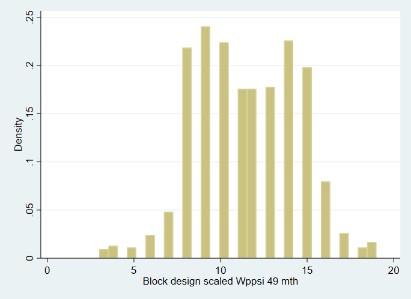The Avon Longitudinal Study of Parents and Children (ALSPAC) assessed their cohort members (CMs) at 49 months’ age (Children in Focus Clinic) using the Block Design measure from the Wechsler Preschool and Primary Scale of Intelligence Revised (WPPSI-RUK).
Details on this measure and the data collected from the CMs are outlined in the table below.
| Domain: | Non-verbal ability |
| Measures: | Planning |
| Spatial visualisation | |
| Visual motor coordination | |
| Simultaneous processing | |
| Synthesis (part-whole relationships) | |
| Non-verbal concept formation | |
| CHC: | Gf (Fluid intelligence) |
| Gs (Processing speed) | |
| Gv (Visual processing) | |
| Administration method: | Trained interviewer; clinical setting; physical task |
| Procedure: | The child was presented with an image or model that depicted a pattern, and was tasked with recreating the pattern with one- and two-colour blocks (white and red). The test contained 14 designs, and the child was allowed two attempts at each design. Points were awarded for completion, and bonus points were awarded based on time. |
| Link to questionnaire: | http://www.bristol.ac.uk/alspac/researchers/our-data/clinical-measures/ (opens in new tab) |
| Scoring: | Standardised score (M = 10, SD = 3) |
| Item-level variable(s): | Not readily available |
| Total score/derived variable(s): | cf803 |
| Descriptives: | Raw score |
| N = 1,013 | |
| Range = 3 - 19 | |
| Mean = 11.45 | |
| SD = 2.95 | |
(click image to enlarge) |
|
| Age of participants: | Mean = 212.39 weeks, SD = 1.63, Range = 207 - 221 |
| Other sweep and/or cohort: | ALSPAC - Age 8.5 - WISC-III Block Design |
| MCS - Age 5 - BAS II Pattern Construction | |
| MCS - Age 7 - BAS II Pattern Construction | |
| Source: | Wechsler, D. (1989). Wechsler Preschool and Primary Scale of Intelligence-Revised. WPPSI-R. Psychological Corporation. |
| Technical resources: | Kaufman, A. S., & Lichtenberger, E. O. (2000). Essentials of WISC-III and WPPSI-R Assessment. John Wiley & Sons Inc. |
| Reference examples: | Bornstein, M. H., Hahn, C. S., Bell, C., Haynes, O. M., Slater, A., Golding, J., ... & ALSPAC Study Team. (2006). Stability in cognition across early childhood: A developmental cascade. Psychological Science, 17(2), 151-158. |
| Taylor, C. M., Kordas, K., Golding, J., & Emond, A. M. (2017). Data relating to prenatal lead exposure and child IQ at 4 and 8 years old in the Avon Longitudinal Study of Parents and Children. Neurotoxicology, 62, 224-230. |
For the named item in the table above, a link is provided to the corresponding CLOSER Discovery content.
Go to:
- Overview of all cognitive measures in ALSPAC
- Overview of childhood cognitive measures across all studies
This page is part of CLOSER’s ‘A guide to the cognitive measures in five British birth cohort studies’.
